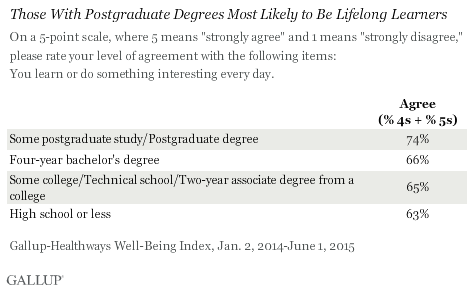Story Highlights
- Majority say they learn something interesting every day
- Postgrads are only education level that is more likely to agree
WASHINGTON, D.C. -- Nearly three-quarters of U.S. adults with education or training beyond a four-year college degree agree that they learn or do something interesting every day. This is higher than those with a bachelor's degree only (66%), some college or a two-year associate degree (65%), or a high school education or less (63%).

Gallup and Healthways ask adults in the U.S. to rate their level of agreement with the statement, "You learn or do something interesting every day," on a five-point scale. Along with other questions, Gallup uses this measure to calculate the extent to which someone is thriving -- or strong and consistent -- in his or her purpose well-being. Purpose well-being -- defined as liking what you do each day and being motivated to achieve your goals -- is just one of the five well-being elements that the Gallup-Healthways Well-Being Index measures.
Because factors such as income could affect education levels and, therefore, learning or doing interesting things on a daily basis, the analysis accounted for age, gender, race, income, region and marital status among the percentage who agreed with the statement.
Researchers could measure lifelong learning in a number of quantifiable, activity-based ways, such as asking graduates how many books or articles they have read as well as whether and how often they visit a library or search the Internet for new information. Or researchers could measure it by asking more abstract questions, including whether graduates seek out conversations with people from diverse backgrounds or foreign countries. By asking whether someone agrees that they learn or do something interesting every day, Gallup and Healthways can discern whether graduates are still learning later in life or not.
Bottom Line
Higher education institutions across the U.S. share similar mission and purpose statements. These statements often include a core goal of "fostering lifelong learning" among students and graduates. While this is a commonly shared goal among higher education institutions, it is difficult to identify a way to measure whether students and graduates are indeed becoming lifelong learners.
The Gallup-Healthways Well-Being Index provides a tangible metric with which to evaluate it: The majority of Americans, no matter what their education level, agree that they learn or do something interesting every day. However, when looking at levels of educational attainment, it is not until the postgraduate level that there is a meaningful difference in terms of someone believing that he or she gets to learn or do something interesting every day.
Other factors independent of education level can influence daily learning as well, including the culture of the city or area where one resides. Prior Gallup analyses show that cities with a heavy academic presence tend to score higher in overall well-being, which is supported in part by residents saying that they learn new and interesting things every day. Cities with a strong academic presence likely provide residents with more chances to learn and do interesting things through community events and educational opportunities.
As Americans scrutinize the value of a college degree -- from whether it improves their job prospects to whether it helps them become engaged citizens and lifelong learners -- it is necessary for colleges and universities to do more to measure and track long-term outcomes, as well as make good on the promises made in their mission statements and touted in admissions brochures.
Survey Methods
Results are based on telephone interviews conducted Jan. 2, 2014-June 1, 2015, as part of the Gallup-Healthways Well-Being Index survey, with a random sample of 251,193 adults, aged 18 and older, living in all 50 U.S. states and the District of Columbia. For results based on the total sample of Americans, the margin of sampling error is ±0.2 percentage point at the 95% confidence level, including computed design effects for weighting.
Each sample of national adults includes a minimum quota of 50% cellphone respondents and 50% landline respondents, with additional minimum quotas by time zone within region. Landline and cellular telephone numbers are selected using random-digit-dial methods.
Learn more about how the Gallup-Healthways Well-Being Index works.
With contributions from Diana Liu.


